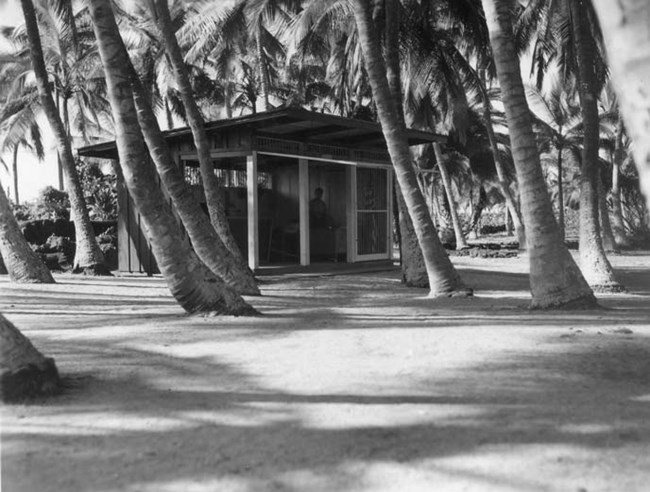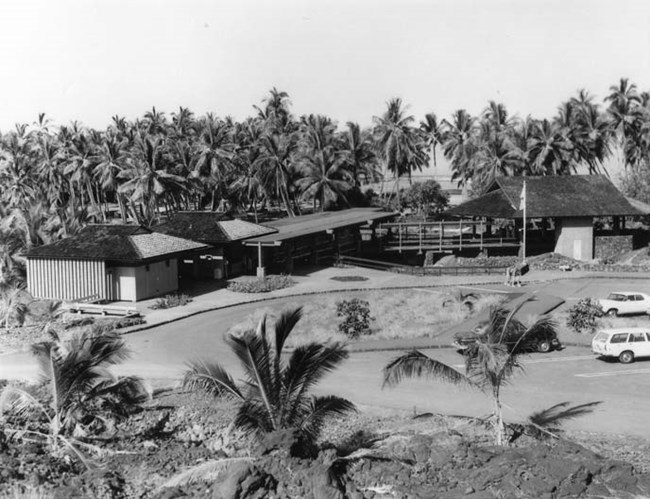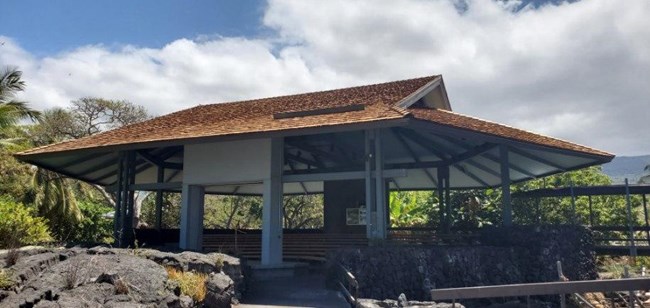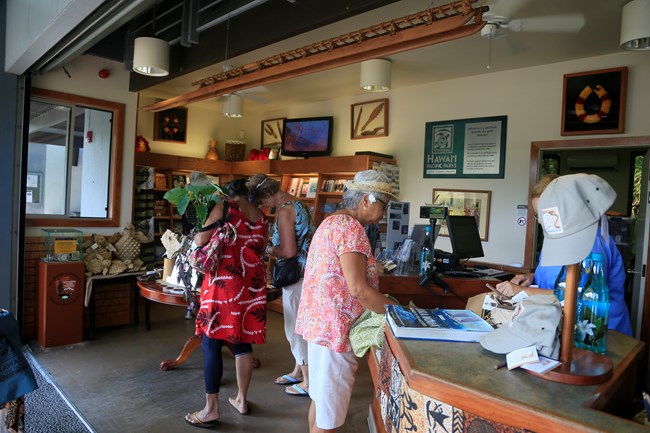

Left image
Right image
Stories of Preservation: The Visitor Center
NPS, Pu‘uhonua o Hōnaunau National Historical Park, PUHO 875 Visitors from around the world come to Puʻuhonua o Hōnaunau National Historical Park to immerse themselves in Hawaiian culture and see the many historical and cultural sites that are preserved and protected by the park. Sites like Hale o Keawe, the pā puʻuhonua (Great Wall), and the kiʻi images easily capture the awe and fascination of visitors, leaving the Visitor Center Complex often overlooked. You may be thinking, almost every park has a visitor center, why would this one be special? Surprisingly enough, the Puʻuhonua o Hōnaunau National Historical Park (PUHO) Visitor Center Complex is part of a larger national story: the Mission 66 Program. 
NPS, Pu‘uhonua o Hōnaunau National Historical Park, PUHO 3239 Constructed between 1968 and 1969, the Visitor Center at Pu’uhonua o Hōnaunau National Historical Park represents the only existing Mission 66-style Visitor Center in Hawai’i and is one of only 107 visitor centers designed and built by the National Park Service under the Mission 66 program. Adhering to the vision of the Mission 66 program, the PUHO Visitor Center is designed to be the central point of the park and provides the basis for the overall design and flow of the park experience. The Visitor Center represents an expression of American modern architecture yet retains the feeling of Polynesian-style architectural design. This can be found in such design elements as the lava rock walls that line the building as well as the 'ili 'ili (water worn pebbles) paved walkways. These architectural traits were specifically chosen to create a connection between the overall design of structure and where it is located within the cultural landscape. 
NPS Photos The original interpretive wall display still remains a key feature in the Visitor Center Complex. Designed to mindfully blend interpretive graphics and architectural design with a recorded interpretive story, the interpretive wall’s bold, distinctive images convey the intensity of the history of Hawaiian culture. In 1974, revisions to the original design were made to correct factual mistakes within the murals. Minor changes to the depictions of Polynesian plants, articles of clothing, and animals were made to add to the historical accuracy of the mural. 
NPS Photo In 2002, the Visitor Center was determined eligible for listing on the National Register of Historic Places (NRHP) under Criterion A, C, and G. As indicated on the nomination form, the Visitor Center is of national importance under the NRHP Criterion A because is it associated with events that have made a significance contribution to the broad patterns of our history, the Mission 66 program. Under Criterion C the visitor center property embodies the distinctive characteristics of a type, period, or method of construction. This refers to the “National Park Service Modern Architecture” where architects used both modern styles as well as regional influences to create a seamless visitor experience. Finally, eligibility under Criterion G requires that properties less than fifty years of age possess “exceptional importance” if they are to be determined eligible for the register. Since the visitor center was the only Mission 66 visitor center on the island of Hawai’i and remained in good condition, it was determined that it was also eligible under Criterion G as well. 
Photo: D. Boyle The National Park Service continues to preserve this historically significant building complex for future generations to experience. While the “office/information desk” has transformed to incorporate a bookstore and additional office space has been constructed, most of the buildings remain in their original form. Just like any building, routine maintenance such as roof tile replacement, painting, and minor repairs have been made to continue to preserve the integrity of the buildings. Additionally, over the years, major earthquakes have resulted in damage to the visitor center (cracks in posts and concrete masonry bases) and repairs have since been made. |
Last updated: May 10, 2020
